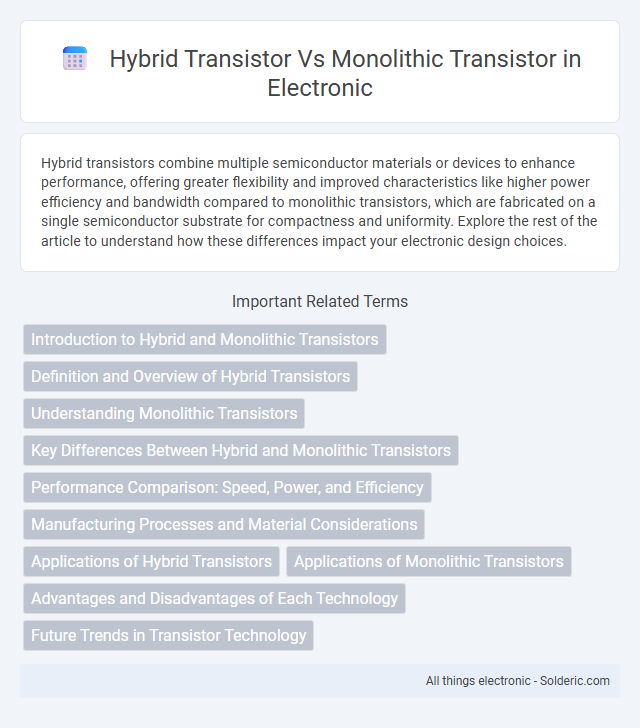Hybrid transistors combine multiple semiconductor materials or devices to enhance performance, offering greater flexibility and improved characteristics like higher power efficiency and bandwidth compared to monolithic transistors, which are fabricated on a single semiconductor substrate for compactness and uniformity. Explore the rest of the article to understand how these differences impact your electronic design choices.
Comparison Table
| Feature | Hybrid Transistor | Monolithic Transistor |
|---|---|---|
| Construction | Combination of multiple discrete transistor components | Single integrated transistor fabricated on one semiconductor chip |
| Size | Generally larger due to discrete parts | Compact and small in size |
| Performance | Good for high power applications | Optimized for high-speed and low-power applications |
| Manufacturing Cost | Higher due to assembly of multiple parts | Lower with mass production capabilities |
| Reliability | Moderate, affected by interconnections | High, fewer connections reduce failure rates |
| Application | Power amplifiers, discrete switching | Microprocessors, signal processing, integrated circuits |
Introduction to Hybrid and Monolithic Transistors
Hybrid transistors combine discrete semiconductor components and passive elements on a single substrate, enabling customized performance for specific applications. Monolithic transistors are fabricated entirely on a single semiconductor chip through integrated circuit technology, offering high reliability and compact size. Both technologies serve distinct roles in electronics, with hybrid transistors excelling in power handling and monolithic transistors dominating miniaturized, high-speed circuits.
Definition and Overview of Hybrid Transistors
Hybrid transistors combine multiple discrete semiconductor components and passive elements on a single substrate, offering enhanced performance by integrating the strengths of individual devices. Unlike monolithic transistors, which are fabricated in a single semiconductor crystal, hybrid transistors allow for greater customization and higher power handling capabilities. Your choice of hybrid transistors can improve circuit efficiency and thermal management in complex electronic applications.
Understanding Monolithic Transistors
Monolithic transistors are semiconductor devices fabricated on a single silicon chip, ensuring compact size, improved reliability, and consistent electrical performance. Unlike hybrid transistors, which combine multiple discrete components, monolithic transistors integrate all necessary elements, reducing parasitic capacitance and resistance. Your designs benefit from enhanced speed and efficiency due to the inherent precision and scalability of monolithic transistor technology.
Key Differences Between Hybrid and Monolithic Transistors
Hybrid transistors integrate discrete semiconductor components on a separate substrate, allowing customization and improved thermal management, while monolithic transistors are fabricated entirely within a single semiconductor chip, offering compactness and higher reliability. Hybrid versions typically support higher power and frequency ranges due to external component integration, whereas monolithic transistors excel in mass production and miniaturization for cost-effective applications. The key distinctions lie in their fabrication methods, size, performance stability, and suitability for specific electronic circuit designs.
Performance Comparison: Speed, Power, and Efficiency
Hybrid transistors typically offer higher power handling capabilities and enhanced thermal management compared to monolithic transistors, which contributes to better efficiency in high-power applications. Monolithic transistors excel in speed due to their integrated circuit design, enabling faster switching times and lower parasitic capacitance. Understanding these differences helps you choose the right transistor for applications requiring either high-speed performance or robust power efficiency.
Manufacturing Processes and Material Considerations
Hybrid transistors involve the assembly of discrete components on a substrate, combining different semiconductor materials such as silicon and gallium arsenide to optimize performance, whereas monolithic transistors are fabricated from a single semiconductor wafer, typically silicon, using integrated circuit processes like photolithography and doping. The manufacturing process of monolithic transistors emphasizes miniaturization and reproducibility through batch processing, while hybrid transistors allow for easier customization and material integration but face challenges in scaling and thermal management. Material considerations in monolithic transistors focus on uniformity and purity to ensure high yield and device reliability, whereas hybrids must address interconnect quality and material compatibility to prevent performance degradation.
Applications of Hybrid Transistors
Hybrid transistors are extensively used in high-frequency and high-power applications such as RF amplifiers, microwave circuits, and satellite communication systems due to their superior thermal stability and customizable semiconductor materials. These transistors excel in aerospace and defense electronics where precise control and robustness are crucial. Their integration in hybrid integrated circuits enhances performance in radar systems and wireless communication devices, making them ideal for specialized high-performance applications.
Applications of Monolithic Transistors
Monolithic transistors are extensively used in integrated circuits for mobile phones, computers, and consumer electronics due to their compact size and high reliability. They enable efficient signal amplification and switching in RF applications, power management, and analog circuits. These transistors support mass production with consistent performance, making them ideal for automotive electronics and industrial control systems.
Advantages and Disadvantages of Each Technology
Hybrid transistors offer advantages such as higher power handling, better thermal management, and the ability to integrate different materials for optimized performance, but they face challenges including larger size and higher manufacturing costs compared to monolithic transistors. Monolithic transistors provide benefits like compact size, lower production costs, and faster switching speeds due to their integration on a single semiconductor substrate, though they may have limitations in power dissipation and thermal resistance. The choice between hybrid and monolithic transistors depends on application requirements such as power levels, frequency response, and cost constraints.
Future Trends in Transistor Technology
Future trends in transistor technology emphasize the integration of hybrid transistors, combining the benefits of monolithic and discrete components to achieve higher performance, reduced power consumption, and enhanced scalability. Monolithic transistors continue to evolve with advanced materials like gallium nitride and silicon carbide, pushing the limits of speed and thermal stability for next-generation electronic applications. Emerging trends also focus on 3D integration and flexible electronics, where hybrid transistor architectures enable innovative device configurations beyond traditional planar monolithic designs.
Hybrid transistor vs Monolithic transistor Infographic

 solderic.com
solderic.com